Alcohol: India
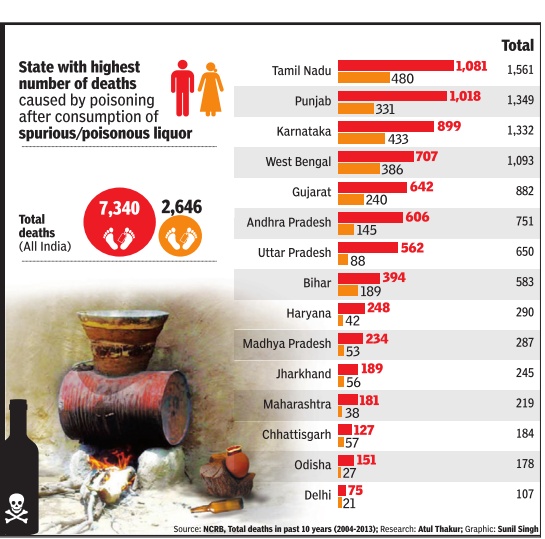
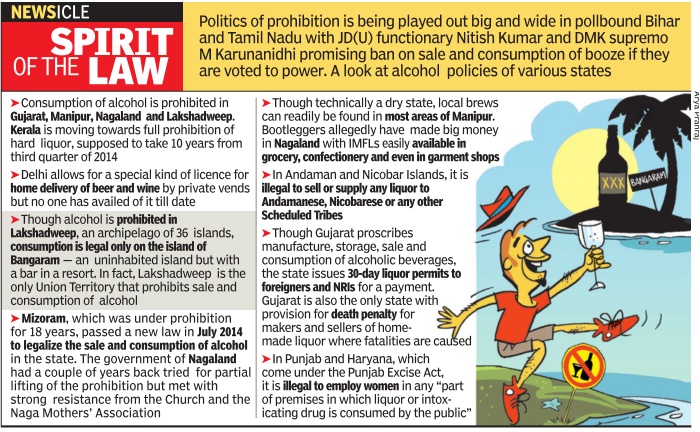
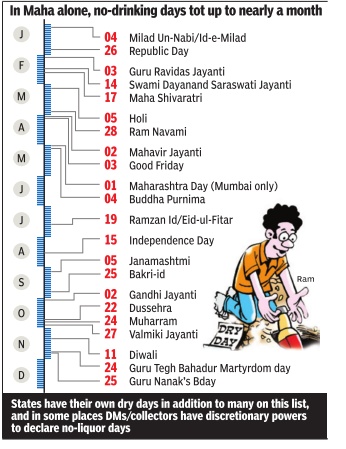
This is a collection of articles archived for the excellence of their content. |
The law
Alcohol consumption not a right: HC
Consumption of alcohol not a right: Kerala HC, The Times of India Jan 2017
Upholding the liquor policy of the previous government, the Kerala HC ruled that consumption of alcohol is not a fundamental right. “ To drink or not to drink. That is the Hamletian dilemma of Anoop.He has chosen to drink,“ it said while referring to the petitioner.
Consuming liquor in private without causing nuisance is no offence
Nov 16, 2021: The Times of India
The mere smell of alcohol on a person is not sufficient to book him for being in a public place in an intoxicated manner, the Kerala high court said.
Justice Sophy Thomas made the observation on a petition filed by Salim Kumar of Kollam through advocate IV Pramod. The petitioner, a village assistant, had challenged a case registered by Badiadka police under Section 118(a) of the Kerala Police Act.
As per Section 118(a), any person found in a public place in an intoxicated manner or riotous condition or incapable of looking after himself can be booked for causing grave violation of public order or danger.
The petitioner had said he was called to the police station at 7 pm to identify an accused and a false case was registered as he couldn’t identify the accused as required by police as the accused was a stranger to him.
The HC said, “Consuming liquor in a private place without causing nuisance or annoyance to anybody will not attract any offence. Mere smell of alcohol also can’t be construed to mean that the person was intoxicated or was under the influence of any liquor.” Even if the petitioner had consumed alcohol, the available facts and materials in the case are not sufficient to suggest that he was not able to control himself or he committed rioting inside the police station, it said. TNN
Even if the petitioner had consumed alcohol, the available facts in the case are not sufficient to suggest that he wasn’t able to control himself or he committed rioting inside the police station, the HC said
Spurious liquor
MP: death penalty for lives lost
August 11, 2021: The Times of India
The Madhya Pradesh assembly passed MP Excise (Amendment) Bill, which proposes death penalty and life imprisonment for death caused by spurious liquor.
Spurious liquor has claimed over 50 lives in the state in around 10 months. The death of around 17 people in recent liquor tragedies in Mandsaur and Indore was the trigger for the move.
As per the amendment, sale or manufacture of spurious liquor will lead to six years’ imprisonment and a fine of Rs1 lakh for the first offence. For the second offence, the punishment will be 10 years in jail and a fine of Rs 10 lakh, said state finance minister Jagdish Devda.
If spurious liquor causes harm to anyone, the manufacturer will face an eight-year jail term and a fine of Rs 2 lakh. If it causes death, the punishment is life term or death penalty, plus a fine of Rs 20 lakh. All these offences will be non-bailable, said Devda. TNN
Quantity of alcohol that can be stored at home/ Delhi, 2022
Abhinav Garg, March 4, 2022: The Times of India
New Delhi: The Delhi high court has highlighted that a person above 25 years can keep 9 litres of whisky, vodka, gin and rum and 18 litres of beer, wine and alcopop (flavoured a lcoholic drinks). In a recent order, HC quashed a case against a man who had stored 132 bottles of liquor totalling 107. 2 litres at home, pointing out that as there were six adults in his family, the total permissible limit would have been 162 litres.
During a raid by the excise department in 2020, the petitioner had been found storing 51. 8 litres of whisky, rum, v odka, gin and 55. 4 lit res of wine and beer. A total of 132 bottles of liquor of Indian and foreign brands had been discovered from the ground floor of his house in Panchsheel Park. The excise department booked him saying that he did not have a valid licence for the stored liquor and that the stock was beyond the permissible limit prescribed. Subsequently, an FIR under Section 33 of the Delhi Excise Act was registered against him.
During the hearing, Justice Subramonium Prasad saw merit in the petitioner’s claim that there was no infringement of the excise rules because he lives in a joint family with six adults aged over 25 and four children.
“Flowing from Rule 20, as the joint household consists of six adults above 25 years of age, the permissible limit for possessio n of liquor at his house would be 54 litres of whisky, vodka, gin and rum and 108 litres of beer, wine and alcopop. Therefore, prima facie there is no violation of the Delhi Excise Act, 2009 by the petitioner,” the court noted.
As per Rule 20 of Delhi Excise Rules, 2010, violation of maximum limit for retail sale and individual possession of liquor is an offence punishable with imprisonm ent for a maximum term of three years and a fine not less than Rs 50,000, which may extend to Rs 1,00,000.
Justice Prasad also pointed out that as per the law, a person can carry one litre of In dian or foreign liquor while entering Delhi from other states and two litres while entering from other countries.
Banning alcohol, state-wise
Uttarakhand HC declares holy circuit dry zone
AmitAnand Choudhary, Don't try to play lawmaker, SC tells judges, Dec 9, 2016: The Times of India
Uttarakhand high court ordered the state government to impose a complete ban on possession, distribution, collection, sale, purchase or consumption of liquor, including beer, in Rudrapra yag, Chamoli and Uttarkashi districts, where the Char Dham shrines are located, from the financial year (2017-18).
The court noted that Bihar, taking into considera tion the “evil consequences of consumption of liquor“, had imposed complete prohibition on it across the state.
Kerala
The number of sales outlets in 2017
VIJAYAWADA|50,000 belt shops, 4,380 liquor outlets and 768 bars in State July 26, 2017: The Hindu
80% public say no to unauthorised liquor outlets: survey
There are about 50,000 belt shops (unlicensed liquor outlets) in the State. With Chief Minister N. Chandrababu Naidu directing the officials to act tough on belt shop organisers, officers are conducting raids on them.
N. Sambasiva Rao, DGP, said the police and the Prohibition and Excise Department officials were taking steps to close them down.
“A survey was taken up on the belt shops and about 80% of the public say no to the unlicensed liquor outlets and asked the government to close them immediately,” the DGP said.
“Belt shops are being run in different modes. The organisers are selling liquor on push carts, pan shops, houses, dhabas, hotels, kirana shops, bicycles [on the pretext of selling tea] and other ways. We are taking action against those who are running them,” Mr. Rao said.
The police were also taking action against the tipplers consuming liquor on roads and public places. Instructions had been issued to intensify patrolling at the liquor shops and bars to prevent consumption of liquor openly, a police officer said.
773 belt shop organisers held
Speaking to The Hindu on Tuesday, Prohibition and Excise Director (Enforcement) K. Venkateshwara Rao said 757 belt shops had been closed and cases were booked against 773 organisers in the last seven days. Excise officials suspended the licences of 46 wine shops for selling stock to outsiders.
“We seized 3,339 litres of liquor and 940 litres of beer, being sold in belt shops. Special Task Force teams have been constituted to check belt shops. We will take action against the wine shop owners, if the stock is sold to any outsider or an establishment. Owners of the licensed liquor outlets will be made responsible if tipplers take liquor on roads,” the DGP warned.
Drug and alcohol deaddiction
2013-16: aid for rehabilitation centres
See graphics:
Funds released for assistance for prevention of alcoholism and substance abuse, 2013-16
Consumption of beer in 2016
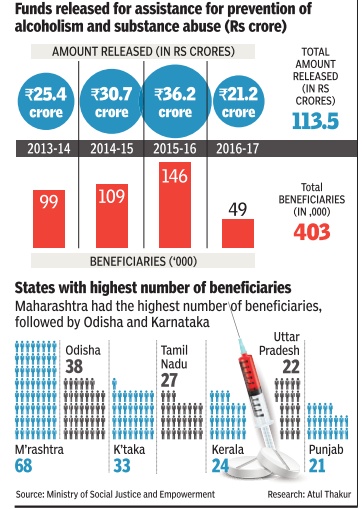
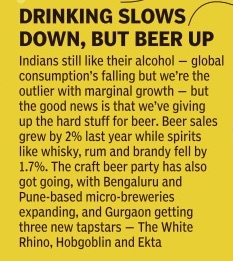
The economics of alcohol
Consumption, revenues, types sold, toll: 2016-20
Prabhakar Jha and Kanishk Sharma, April 8, 2021: The Times of India
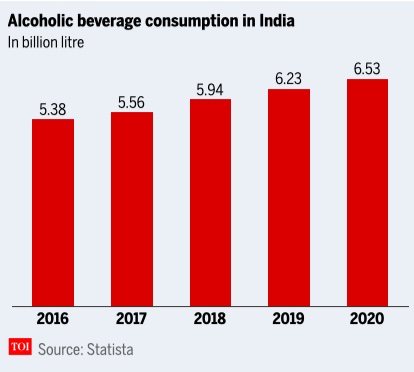
From: Prabhakar Jha and Kanishk Sharma, April 8, 2021: The Times of India
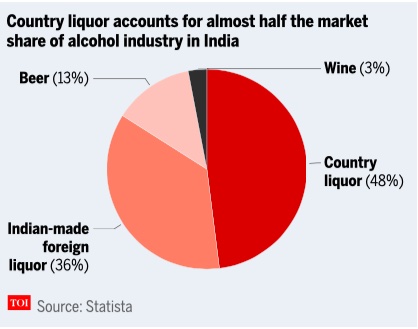
From: Prabhakar Jha and Kanishk Sharma, April 8, 2021: The Times of India
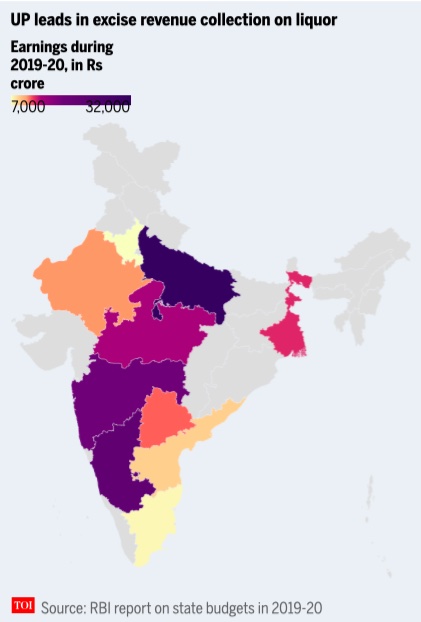
From: Prabhakar Jha and Kanishk Sharma, April 8, 2021: The Times of India
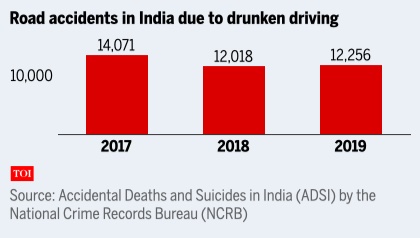
From: Prabhakar Jha and Kanishk Sharma, April 8, 2021: The Times of India
Sachin Mangal’s face lights up as he talks about his weekend plans. Delhi government’s recent order reducing the drinking age to 21 from the earlier 25 years has added fizz to the 23-year-old engineering student’s plans.
It has also made his life simpler.
“Now my friends and I don’t have to use fake IDs or go to Noida to buy booze,” says Mangal who lives in Dwarka, Delhi. Delhi was among the few states and Union territories that had a higher age bar even as the rest of the country had moved on. For sure the Delhi government, or for that matter any state government, was not acting as a party facilitator. Taxes from alcohol sales add to government revenue.
A huge chunk of revenues that state govts earn is from the sale of liquor
No surprises here as many states in the country get a major chunk of their revenue from sale of liquor.
Uttar Pradesh earned Rs 17,320 crore in the 2017-18 fiscal. Despite the closure of liquor shops for the entire April and part of May in 2020, excise revenue for financial year 2020 is estimated to be Rs 31,517.41 crore, according to a Reserve Bank of India (RBI) report.
In simple terms, the government wants more revenue collections from liquor and the move to reduce the drinking age will allow more people to buy booze.
Join the pawri
India's state governments earned around Rs 1.75 lakh crore from excise duty alone in 2019-20, most of which came from liquor sales, according to an RBI report.
The Delhi government earned Rs 6,574 crore in financial year 2019-20, which was about 9.5% of the total estimated revenue, according to the budget presented by deputy chief minister Manish Sisodia.
By lowering the drinking age and thus allowing more people to buy booze the Delhi government hopes to augment the state excise revenue by 20% in the financial year 2021-22. Quoting a Statista research, "the drinks business website" said more than 88% of Indians aged under 25 buy or drink alcohol in some form. By bringing the legal age of drinking to 21, India can add 75 million new consumers by 2020. The report went on to say that in 2016, Indians gulped down 5.4 billion litres of alcohol. The country was expected to cross 6.5 billion litre-mark by 2020.
By lowering the drinking age, Delhi hopes to raise the state excise duty by 20%
The Statista research also reported that the Indian alcohol market is expected to grow annually by 8.7%. Most of the governments want to tap into this potential.
What’s your poison?
The Indian alcohol industry comprises four categories - Indian Made Foreign Liquor (IMFL), beer, country liquor and wine. Each of these segments has a sale volume of between 230 million and 260 million cartons per annum, according to a July 2020 report by research firm Medium.
IMFL makes up 36% of the total market by value, beer constitutes 13%, wine a mere 3%, the Statista report said. The report also points out that the country liquor's share in the market is about 48% and is growing at a rate of about 7% per annum.
Adding cheer to the economy
Uttar Pradesh generates its maximum revenue from liquor sales. In the financial year 2019-20, the state generated Rs 31,517.41 crore from alcohol sales. It was followed by Karnataka and Maharashtra at Rs 20,950 crore and Rs 17,477.39 crore respectively, according to the RBI report of 2020.
Twelve states — Tamil Nadu, Kerala, Telangana, Andhra Pradesh, Karnataka, Maharashtra, Delhi, Punjab, Uttar Pradesh, West Bengal, Madhya Pradesh and Rajasthan — account for 75% of liquor consumption in the country, according to the Health and Family Welfare Statistics (HFWS) report of 2019-20.
While some states are raking in moolahs, five states Gujarat, Bihar, Manipur, Mizoram and Tripura -- and the Union Territory of Lakshadweep have banned the sale and consumption of alcohol.
On the wagon?
Data show a complete ban on sale and consumption of liquor in two major states - Bihar and Gujarat – haven’t proved to be a deterrent. Bihar's Nitish Kumar government imposed prohibition in 2015 despite generating a whopping Rs 5,000 crore revenue from booze in the financial year 2014-15. But despite the ban, liquor continues to flow in the state through illegal means.
According to Bihar Police, in 2020, illegal liquor — 510,000 litre of IMFL, 455,000 litre of country liquor, 10,000 litre of toddy and over 12,000 litre of beer — was confiscated in the state.
Police seized around 51.7 lakh litre of country liquor and 94.5 lakh litre of IMFL in the state between April 1, 2016 and January 31, 2021.
In states where alcohol is banned, bootlegging continues unabated The latest National Family Health Survey Report-5 for the year 2019-20 has revealed that 15.5% men above 15 years of age drink alcohol in Bihar. Whereas, in Maharashtra, where there is no prohibition, 13.9% men drink.
Gujarat is also not immune to bootlegging. According to a TOI report, on an average, liquor worth nearly Rs 34 lakh was seized in the state every day in 2019-2020.
Back to the bottle
In Kerala, the sale of liquor in over 700 bars was banned in 2014 by the United Democratic Front government that was in power. It was part of the government's larger plan to make the state liquor-free by 2023. The decision was later reversed by the Left Democratic Front government in 2017.
The Pinarayi Vijayan-led government argued that the state was suffering heavy financial losses due to prohibition. Tourism, which is one of the main revenue generators, was also on the decline due to the liquor ban.
Liquor contributes to around 15% of Kerala's revenue, according to a Crisil report published in May, 2020.
And now the hangover
Though alcohol sales add to government revenues there is a flip side too. And that is not always apparent.
A survey by the Ministry of Social Justice and Empowerment and All India Institute of Medical Sciences (AIIMS), Delhi shows that whereas, 15% of Indians drink alcohol about 5% are affected by alcohol-use disorders. So while a much smaller proportion of Indian consume alcohol (15% against 50% globally), a substantial number of people in India are affected by alcohol-use disorders. "More than 200 diseases and health conditions have harmful alcohol consumption as one of the contributing causes. In fact, in one of our papers, we have estimated that alcohol-related health conditions could cost India about 1.5% of the GDP by the year 2050,” says Dr Atul Ambekar, professor at the National Drug Dependence Treatment Centre, AIIMS, Delhi.
Alcohol kills 2.6 lakh Indians every year either by causing liver cirrhosis, cancer or leading to road accidents caused by drunk driving, according to statistics from the World Health Organization’s (WHO) global status report of 2018.
According to Accidental Deaths and Suicides in India (ADSI) data for 2019 by the National Crime Records Bureau (NCRB), 12,256 road accidents took place in the country due to drunk driving.
Incidence of alcohol consumption

Alcohol consumption in India: 1992-2002
The Times of India, May 17 2015
Sumitra DebRoy
At 55%, India records 3rd highest increase in alcohol consumption
A global study has found that alcohol consumption in India has risen by 55% over a period of 20 years.More worryingly, youngsters are being initiated to alcohol much earlier, while more women are indulging in hazardous and binge drinking.
The Paris-based Organization for Economic Cooperation and Development (OECD) recently published a report examining the economic and health implications of alcohol use among its 34 member and a few nonmember countries. Among a list of 40 nations, India was placed as high as third, only after the Russian Federation and Estonia, for increase in alcohol intake between 1992 and 2012. Countries that closely followed India were China, Israel and Brazil. The OECD report said heavy drinking was alarmingly on the rise among youth and women in many countries. “An increasing proportion of children experience alcohol and drunkenness at early ages. Girls have caught up with boys in the past 10 years,“ it stated.
The percentage of under-15 boys who haven't had alcohol went down from 44% to 30%, while for girls it decreased from 50% to 31% in the 2000s.
The trend of heavy drinking witnessed among the young of all countries has experts worried. “It can be dangerous and have long-term effects such as habit formation or other chronic conditions,“ said hepatologist Dr Aabha Nagral, who consults with Jaslok Hospital.
Binge drinking among the youth has also been associated with increased possibilities of road accidents and disabilities in the report. Dr P C Gupta, director of Sekhsaria Institute of Public Health, quoted a WHO report which said about 30% of Indians consume alcohol, out of which 4-13% are daily consumers and up to 50% of these fall under the category of hazardous drinking.
The OECD researchers evaluated that drinkers from member states were downing an equivalent of over nine litres of pure alcohol per year, which further rose by a few units if home brewed and illegal stocks were taken into account.“All of this amounts to drinking over 100 bottles of wine, or 200 litres of beer, in a year,“ the report stated. Interestingly , Indians featured much lower here as average consumption of pure alcohol hovered around 2.5-3 litres annually .
The findings have set alarm bells ringing within the medical fraternity and health activists who are demanding a national policy to curb alcohol use.
2005-16: gender, age, state and types of liquors consumed
May 19, 2022: The Times of India
The share of Indian men and women drinking alcohol has fallen consistently over the past decade and a half, an analysis of three rounds of National Family Health Surveys shows. Men’s share fell from 32% in 2005-06 to 29% in 2015-16 and then sharply down to 22% in the latest round recorded in 2019-21. Women’s share has consistently stayed low, slipping from just over 2% 15 years ago to about 1% in the last two surveys.
But men in both urban and rural India are drinking more regularly, whereas women are drinking less frequently than five years ago. A smaller percentage of men are drinking in almost all large states except in Himachal Pradesh.
“Most Indians drink to get drunk. So though the share of the population drinking is lower, problem drinking and alcohol dependence are as high as world averages” : Dr Ravindra Rao, National Drug Dependence Treatment Centre, AIIMS
Arunachal Pradesh is the only state where more than half the men drink, according to the 2019-21 survey. But that proportion too has come down from 61.1% in NFHS 3, conducted in 2005-06, to 52.6%. The fall has also been steep among Chhattisgarhi men – the share has declined from 52% to 35% in a decade and a half. Those with no schooling (30%), scheduled tribes (33%), and those aged 35-49 (27%) are the largest groups sorted by education, caste and age.
The highest proportion of women drinkers – 24.2% – is in Arunachal Pradesh, where the home-brewed rice beer called apong is a social drink. The rural-urban gap among women drinkers in this mostly-rural state is also the highest, at more than 11%.
Underage drinking continues, but is lesser
Five states – Himachal Pradesh, Karnataka, Goa, Sikkim, and Puducherry – require a minimum age of 18 to buy alcohol. The minimum age in most other states is 21; Haryana brought it down from 25 to 21 in 2021. Only Meghalaya, Punjab and Delhi have kept the minimum age at 25.
But a survey of 10,000 respondents in Delhi by the Community Against Drunken Driving reported in 2021 that 89% of those below 25 have had alcohol, and more than two-fifths drink 2-4 times a week.
NFHS reports show that teenage boys aged 15-19 have been drinking across India, though their overall share among men who drink has come down from 11% to 5.8% over the 15 years of the three latest survey rounds. The same holds true for girls aged 15-19, but their share too has come down from 1% to 0.2%.
Bengal only large state where urban men drink more
Most drinking averages are driven by rural men, who drink in higher numbers and more frequently than urban men. Only in Nagaland, Goa, Daman and Diu, and West Bengal is this trend reversed among men in the latest survey. Urban women in Ladakh – counted separately for the first time – outstrip their rural counterparts by 2%.
Prohibition not working in any of the 4 states
Of the four states that have banned alcohol, Gujarat imposed the death penalty in 2009 for those making and selling homemade liquors that cause deaths. Bihar imposed prohibition from April 2016, Mizoram from February 1997 (with a gap during 2015-19 when the ban was lifted), and Nagaland from 1989.
Despite the bans, men and women in all four states consume alcohol. Gujarat has issued nearly 60,000 'health permits' to allow residents up to 2021 to drink on medical grounds. But the NFHS-5 data shows that more than 50 times that number admit to having had alcohol.
Though the NFHS, prepared under the Union ministry of health and family welfare, does not give details of the kind of alcohol Indians are drinking, another large-scale household survey on substance abuse commissioned by the ministry of social justice and empowerment does. The highest proportion drinking illicit distilled liquor ( kacchi sharab ) was reported from Bihar, at 30%. Overall, 30% Indians drink country liquor or ‘desi sharaab’, reported the 2019 survey.
Christian, Buddhist men drink harder than others
Among men, alcohol use is the highest – at 47% – among those belonging to religions with smaller populations in India, such as Judaism, Zoroastrianism or those not enumerated as having a religion. Six in 100 Christian and Buddhist men who drink reported drinking almost every day.
Among religions that proscribe alcohol, 30% Sikh men and 6% Muslim men reported drinking. The numbers among women from the communities came in at 0.2% (up from 0 in 2005-06) and almost negligible (down from 0.2%), respectively.
Only 0.8% Hindu women drink – much less than 2.1% Christian and 1.7% Buddhist women – but they drink more frequently than all other major religious groups.
Often-drunk husbands more violent with wives
A third of married women aged 18-49 have faced physical, sexual or emotional violence from their husbands. The most common type of spousal violence is physical (28%), followed by emotional (14%) and sexual (6%).
In Karnataka, almost half the married women reported spousal violence. Telangana, Manipur, Tamil Nadu, Uttar Pradesh, Bihar, Jharkhand, Odisha, Assam, and Andhra Pradesh reported spousal violence above the national average.
And like around the world, the correlation between husbands getting drunk and spousal violence is high in India. Though correlation does not necessarily imply causation, the link is undeniable.
“We know from research that drinking and domestic violence are related, though the level of causation cannot be precisely measured,” says Dr Ravindra Rao of the National Drug Dependence Treatment Centre (NDDTC) at the All India Institute of Medical Sciences.
In India, among women who have faced physical or sexual violence, smaller shares reported that their husbands drank, or drank but didn’t get drunk. But a higher share of wives reported in 2019-21 that their husbands get drunk often.
Problem drinking is near world averages
“Most Indians drink to get drunk. So though the share of the population drinking, or per capita consumption are much lower than world averages, problem drinking and alcohol dependence are as high as the world average,” says Dr Rao.
Dr Rao’s NDDTC prepared the substance abuse survey in 2019 that covered more than 200,000 households across India and reported on a larger segment of the population than NFHS by enumerating those between 10 and 75 years, as compared to the NFHS’s 15-49 age band.
The NDDTC survey showed that 43% of alcohol users – those who have had alcohol in the year before the survey – consume more than four drinks on a single occasion, indicating binge drinking or heavy episodic drinking. Almost 27% get involved in physical fights after drinking, more than a fifth drink during the day, and 4% have suffered road accidents under the influence.
At the national level, about 2.7% are affected by alcohol dependence, the survey concluded, with the highest levels reported from Tripura (13.7%), Arunachal Pradesh (7.2%), Chhattisgarh, Punjab and Andhra Pradesh (around 6% each). It comes down to a truism – anything in moderation is alright. Maybe the next NFHS round will get us more nuanced data on it.
21.4% of Indians consume alcohol: UNODC
The Times of India, Aug 27 2015
Dipak Dash
United Nations Office on Drug and Crime (UNODC) report
DRUG MENACE - RTI: 21.4% of Indians consume alcohol 3% of population hooked to cannabis
Punjab, Maharashtra, Manipur, Tamil Nadu and Andhra Pradesh are among the top 10 states where consumption of alcohol and narcotic drugs is higher than the rest of the country, according to a RTI response from home ministry.
Quoting a survey conducted by the United Nations Office on Drug and Crime (UNODC), the National Institute of Social Defence, a wing of MHA, has submitted that 21.4% Indians consume alcohol while 3% hooked to cannabis. The RTI was filed by a Delhi resident Ved Pal following recent cases of lives lost due to consumption of illicit alco hol in the country.
The RTI reply also mentions the list of 19 states and Union Territories that are in “major grasp“ of alcohol and drugs.Seven of these states are from north India including Delhi, Himachal Pradesh and UP . Except Arunachal Pradesh and Tripura, all other states from the northeast are in the list.
“Governments take the credit that they have earned crores of rupees through taxes and excise duty from the sale of alcohol.But governments should not be into this money making business. The entire amount that they have earned so far should be spent on creating awareness against consumption of alcohol and the rehabilitation of the addicts,“ Ved Pal said.
The UNODC study on “National Survey on Extent, Pattern and Trends of Drug Abuse in India“ that was released in 2004 had found that alcohol, cannabis and opiates are the major substances of abuse in India and the prevalence of drug abuse among males is significant. It had also found how women face the worst and are under huge burden if any member in their families is addicted to alcohol or drugs.
It had recommended the need to have schemes to attract drug users for treatment and developing programmes for vulnerable groups such as youth, street children and prisoners.
2015: Alcohol consumption in India and the world
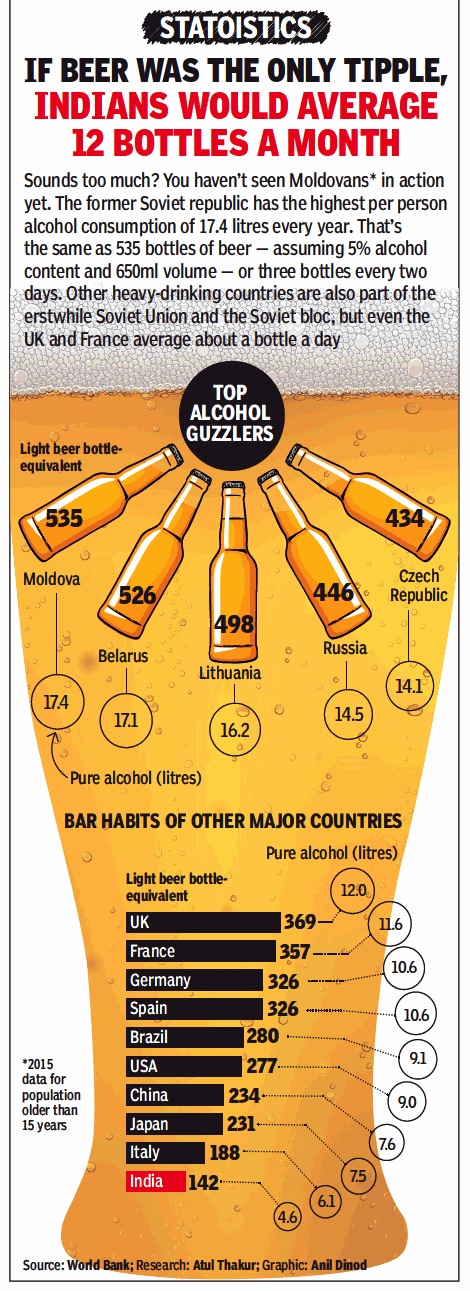
From: May 5, 2018: The Times of India
See graphic:
2015- Alcohol consumption in India, China and the world
2016: Indians drinking more, but not to get drunk
The Times of India, September 11, 2016
John Sarkar
Indians are now drinking more, but not to get drunk A change in tastes and a yearning for aspirational lifestyles have led to the increase in sales of wine and beer.Youngsters have fuelled a boom in tequila, sales of which shot up by 10% in 2014-15.
“Gone are the days when youngsters would stay over at a friend's place and down a bottle of whisky or rum, in the fear that they would get scolded at home. These days, it's more about social drinking over good conversation with soft alcohol such as wine and craft beer,“ said Kapil Sekhri, director of Indian wine company Fratelli Wines.“In every sphere of life, the erstwhile feeling that `alcohol is taboo' is fading away.“
Among wines, sales of still light wine showed 17% growth in 2014-15, the highest among all wine segments, driven mainly by value lines of local brands. Growth of champagne, however, remained muted with demand for rose increasing. Flavours are keeping the vodka category alive too. While sales of plain vodka are showing a decline, flavoured ones are flying off the shelves mainly due to demand from young consumers. It's the same story with rum, with the flavoured variety finding favour with consumers and growing by 45% in 2014-15.
Aspirations are driving consumers to upgrade too. The trend is stark in whisky with the Indian-made foreign liquor (IMFL) category showing higher value growth than volume growth, as consumers have traded up to higher price points.
“The changing consumer dynamic with the growth in disposable income is spurring the demand for premium lifestyle brands,“ said Raja Banerji, AVP-marketing, Pernod Ricard India. “With evolving tastes of the discerning consumer, India has become the third fastestgrowing market for all blended scotch in the past five years.“
Beer, the world's most widely consumed alcoholic beverage, is on a high in India as well. Although growth was affected in 2014-15 due to slack in the IT sector in Karnataka and drought in Maharashtra, the country's largest beer state, the category is still growing thanks to consumers not hesitating to experiment.
“The Indian consumer has come a long way and is willing to experiment, willing to choose `taste over testosterone',“ said Ankur Jain, CEO and founder of B9 Beverages that sells Bira 91, a local craft beer.
“Beer is a highly regulated industry , therefore it's not easy to introduce a new brand every now and then. But there is a huge untapped market with potential, which has pushed for emergence of various brands with unique identities.“
Grocery stores: bars ratio, 2016
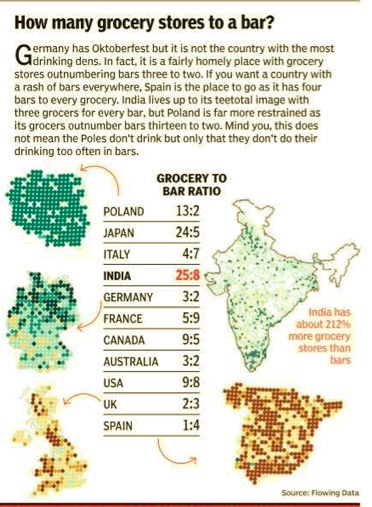
From: The Times of India, October 15, 2017
See graphic:
Grocery to Bar ratio, India and the world, 2016
New Year revelries, 2017/18
Delhi: liquor worth ₹30cr consumed
Booze worth ₹30cr downed on Dec 31, January 4, 2018: The Times of India
Delhiites partied hard on the eve of New Year, gulping down alcohol worth around Rs 30 crore. “There was a spurt in sale of liquor in the city on December 31. As per our records, the sale of alcohol was around Rs 30 crore that day,” a senior government official said.
“The entire month of December has generated Rs 458 crore for the Delhi government since it was a festive season,” the official added.
In the last financial year, Delhi government had earned a revenue of Rs 4,243 crore from the sale of alcohol.
On New Year’s Eve, a total of 1,752 drunken revellers had been penalised by Delhi Police.
Telangana: Rs 100 crore
January 2, 2018: The Times of India
HIGHLIGHTS
Sources said liquor sales were high in unified districts of Nizamabad, Warangal, Karimnagar, Nalgonda and Khammam apart from Greater Hyderabad.
The excise department earned about 20% more on liquor sale in December this year compared to December 2016.
Hike in liquor rates by the state government a few days ago did not weaken the will of tipplers wanting to usher in New Year in high spirits. This was reflected by the fact that nearly ₹100 crore liquor sales were registered only on December 31, 2017. And the excise department earned about 20% more on liquor sale in December this year compared to December 2016.
"In December, the excise department earned ₹1,645 crore, which is about 20% more than December 2016. Our department is getting district-wise details," excise commissioner RV Chandravadan told TOI on Monday. Sources said, while official figures are still being tabulated, indications are that sale of liquor on New Year Eve alone would easily cross ₹100 crore.
Sources said liquor sales were high in unified districts of Nizamabad, Warangal, Karimnagar, Nalgonda and Khammam apart from Greater Hyderabad. Officials and retail outlet owners feared the average 10% rate hike on liquor would have had an adverse impact on sales during New Year celebrations. "Going by the sales, it did not have any impact," they said.
"Over 2,200 retail outlets owners in the state have lifted ₹75 crore worth of liquor a day from December 26 from 17 depots. These six days alone contributed nearly ₹450 crore sales from depots," an official of Telangana State Beverage Corporation Limited (TSBCL) said.
New Year revelries, 2018/19
Delhi
January 9, 2019: The Times of India
Delhi guzzled 16.5L bottles of booze on Dec 31
Delhiites gulped down over 16.5 lakh liquor bottles on the eve of New Year. A Delhi government official said there was a spurt in sale of liquor in the city on December 31.
2019-20
Rema Nagarajan, December 16, 2020: The Times of India
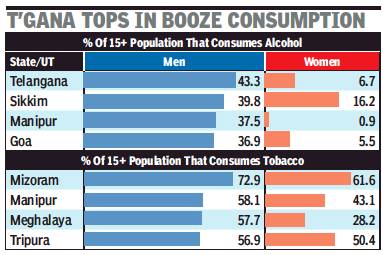
From: Rema Nagarajan, December 16, 2020: The Times of India
You might associate Goa with booze and partying, but a higher proportion of people in Telangana consume alcohol than in the former. And a larger percentage of men drink in Bihar, a state under prohibition, than in Maharashtra. When it comes to tobacco consumption, the northeast is the region that tops the charts, according to data from the National Family Health Survey 2019-20.
Gujarat and Jammu & Kashmir, in that order, have the least consumption of alcohol among men. There is no way of knowing if there has been any change in the consumption of alcohol or tobacco since the last survey as the two data sets are not comparable. In the 2015-16 survey, the data pertained to the age group 15-49 years whereas in the latest survey it is for all above 15 years.
When it comes to women’s consumption of alcohol, Sikkim and Assam, with 16.2% and 7.3%, respectively, top the charts. But here, too, Telangana comes next, topping Goa.
Barring Telangana and Goa, most of the states at the top are in the northeast. The consumption among rural women is significantly higher than in urban areas in most states, which could also be due to less hesitation in admitting to alcohol consumption compared to urban women. This difference in prevalence of alcohol consumption exists between rural and urban men too, but the difference is not as high as among women.
In all states, consumption of tobacco, which includes chewing tobacco and smoking, is much higher than consumption of alcohol. Despite the established connection between tobacco consumption and cancer, the use remains widely prevalent.
Mizoram tops list in tobacco consumption
In India, studies had shown a higher prevalence of tobacco chewing than smoking. The highest consumption of tobacco is in Mizoram, where 77.8% of men and almost 62% of women consume it. Tobacco use is highest among men and women in northeastern states, including Assam. It is lowest in Kerala (17%) and Goa (18%) in the case of men, though Himachal has the lowest consumption of tobacco among women, just 1.7% Tracking of alcohol and tobacco consumption was started from the last survey with growing recognition of the burden of non-communicable diseases in India.
2019-21
Alcohol use in India, 2019-21
Durgesh.NandanJha , August 9, 2022: The Times of India
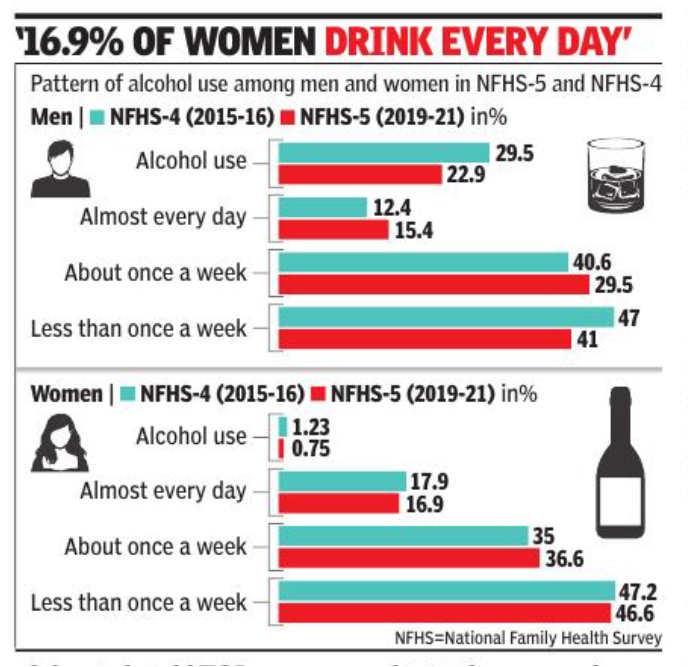
From: Durgesh.NandanJha , August 9, 2022: The Times of India
New Delhi: A study published in the journal Alcohol and Alcoholism suggests that Indian men who drink are doing so more often, comparing trends from the National Family Health Survey conducted in 2019-21 and 2015-16. Among the men who said they drank, 15. 4% said they used alcohol ‘almost every day’ in the latest survey, 43. 5% ‘about once a week’ and 41% ‘less than once a week’. In 2015-16, 12. 4% of male respondents said they drank almost every day while 40. 6% said they drank about once a week. Among women, the study found, 16. 9% said they drank ‘almost every day’ in the latest survey. The proportion of those using alcohol ‘about once a week’ and ‘less than once a week’ was 36. 6 and 46. 6% respectively, the study found. The first two categories registered a fall compared to the 2015-16 survey. “It is a positive sign that fewer people are drinking. But, the study shows how the frequency of drinking among those who consume alcohol has gone up. This needs to be checked to prevent alcohol-related problems,” Dr Yatanpal Singh Balhara, one of the authors of the study, told TOI.
The states of Gujarat (at the time of both NFHS-4 and NFHS-5) and Bihar (at the time of NFHS-5), and the Union Territory of Lakshadweep (at the time of both NFHS-4 and NFHS-5) had prohibition of alcohol consumption.
According to the study report, 0. 4% men in Lakshadweep said they drink while none of the women reported alcohol use. In the state of Bihar, 15. 5% of men and 0. 4% of women reported current use of alcohol. The proportions were 5. 8 and 0. 6% for men and women, respectively for Gujarat, according to the study. “Although there has been a reduction in the proportion of Indian men and women who reported alcohol use between NFHS-4 and NFHS-5, the increase in the proportion of men who reported alcohol use ‘almost every day’ is a finding that requires greater focus and is a need to strengthen the investment in the initiatives targeted at the harms due to alcohol use,” the researchers say.
Laws restricting alcohol sales
1. Hyderabad/ Telangana
The Telangana government has implemented a ban which prohibits the sale of alcohol within 100 metres of the state, or national highways. That means, no liquor store or pub can be open within a distance of 100 metres. Even three and five-star hotels aren't exempt from this rule.
2. Uttar Pradesh + all other states.
While most parts of the country have a minimum drinking age of 21, in places like Delhi, Haryana, Punjab and Meghalaya it's 25. Not to forget the minimum drinking age in Goa, Madhya Pradesh, Himachal Pradesh and Puducherry still remains 18.
3. Punjab + Haryana
Establishments in Punjab and Haryana, according to the Punjab Excise Act of 1914, are prohibited from hiring "women in any part of such premises in which such liquor or intoxicating drug is consumed by the public". Yes, no woman can be employed anywhere near a place when alcohol is being served.
4. Lakshadweep
Lakshadweep is the only union territory in India where alcohol consumption is prohibited. Since 1995, residents cannot drink anywhere except this little island called Bangaram.
5. Maharashtra
Not only is 25 the legal age of drinking in Maharashtra, but one also needs to have a licence to consume liquor. Possession, consumption, or even transportation of alcohol without a permit/licence can result in a fine of Rs.50,000 and/or 5 years in prison. To make things easier for the consumer, hotels and bars started buying these permits in bulk and giving them away to their guests. However, Wardha, Chandrapur and Gadchiroli are the only three districts of Maharashtra that have completely banned the consumption and sale of alcohol.
6. Andamans
Between 2008 and 2010, the last day of every month would be a dry day! Although not confirmed by officials, it believed that the law was to prevent people working for a salary from splurging all their money on alcohol. Additionally, for some odd reason, the 7th day of every month still remains a dry day in the state.
7. Assam
In Assam, every month end and 1st day of the month is dry day... (Arnab Phonglosa)
Legal drinking age
All states
The following information has been taken from the website of the Indian National Bar Association. At least on UP they were factually wrong, and Indpaedia has corrected them:
Andhra Pradesh 21
Arunachal Pradesh 21
Assam25
Bihar 21
Chandigarh25
Delhi25
Goa 18
Gujarat Illegal
Haryana 18
Himachal Pradesh 18
Jammu and Kashmir 21
Jharkhand 21
Karnataka 21
Kerala 21
Lakshadweep Illegal
Madhya Pradesh 18
Maharashtra 25
Manipur Illegal
Meghalaya25
Mizoram Illegal
Orissa 21
Puducherry 18
Punjab25
Rajasthan 18
Sikkim 18
Tamil Nadu 21
Uttar Pradesh 21 (not 18)
Uttrakhand 21
West Bengal 21
The Times of India added on Jun 25, 2011:
Indeed, the legal drinking age of 25 that prevails in some Indian states, including Maharashtra and Delhi, is by far the highest in the world. It is outdone only by the 30 drinking-age limit in force in Maharashtra state’s district of Wardha.
States like Kerala and Sikkim allow drinking from 18 while in Arunachal Pradesh and Tamil Nadu, the legal drinking age is 21—as is the case in Karnataka, West Bengal, Bihar and Uttar Pradesh.
As in 2021 March
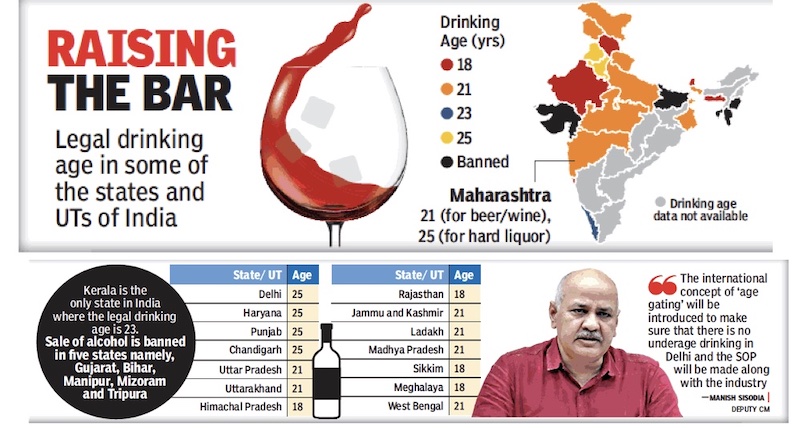
From: March 23, 2021: The Times of India
See graphic:
The Legal drinking age in various states and UTs, As in 2021 March. Delhi lowered the age to 21 that month.
Karnataka: 21 years
Is legal age to drink in Karnataka 18 or 21? | SEPTEMBER 22, 2016 | The Hindu
Even Wikipedia shows the State’s drinking age as 18, and this confusion is repeated in numerous online forums.
Ashish Kothare, city Head of National Restaurant Association of India (NRAI), believes there was little confusion among responsible pub and bar owners who do not allow those under 21 years to enter the pubs. “For many, the mere threat of suspension of licences is enough…But, there are irresponsible bar owners, and action should be taken against them,” he said.
Kerala: 23 years
Kerala Loosens Alcohol Ban, Minimum Drinking Age Raised To 23 The Left government in Kerala has moved to drastically dilute its predecessor's ban on alcohol by allowing hotels that are three-stars or fancier to sell alcohol. While the ban has been loosened, the minimum drinking age has been raised from 21 to 23.
Uttar Pradesh: 21 years, since 1976
The United Provinces Excise Act, 1910 allowed the consumption of Alcohol at 18-years. This was changed to 21-years by an amendment made in 1976.
The relevant sections of the amended United Provinces Excise Act read as follows: (UP Excise)
22. Prohibition of sale to persons under the age of [Twenty One Years] - No license[d] vendor and no person in
the employ of such vendor and acting on his behalf shall sell or deliver any [liquor] or intoxicating drug to any person
apparently under the age of [Twenty One Years] whether for consumption by such person or by any other person and
whether for consumption on or off the premises of such vendor.
23. Prohibition of employment of persons under the age of [Twenty One Years] and of women –
(1) No person who is licensed to sell [liquor]6 for consumption on his premises shall during the hours in which such premises are kept open for business, employ or permit to be employed, either with or without remuneration any [person] under the age of [Twenty One Years] , in any part of such premises in which such liquor or spirit is consumed by the public.
(2) No person who is licensed to sell foreign liquor for consumption on his premises shall, without the previous permission in writing of the [Excise Commissioner] during the hours in which such premises are kept open for business, employ or permit to be employed, either with or without remuneration, any woman in any part of such premises in which liquor is consumed by the public.
(3) Every permission granted under sub-section(2) shall be endorsed on the license, and may be modified or withdrawn
Taxes
As in 2023
Sidhartha, Sep 25, 2023: The Times of India
NEW DELHI: For several travellers, Goa is not just about its beaches but also about the cheap liquor - thanks to lower levies. The state has among the lowest tax rates in India, which is in sharp contrast to neighbouring Karnataka, which has the highest levy among the large markets in the country.
An analysis done by industry body The International Spirits and Wines Association of India for TOI has estimated that a bottle of spirit - which means whisky, rum, vodka and gin - that costs Rs 100 in Goa can cost Rs 134 in Delhi and as much as Rs 513 in Karnataka (see graphic).
At 49% of the MRP, the levies in Goa are by no means low. But they are much lower than the 83% in Karnataka and 71% in Maharashtra. The price index factors in the import duty levied on the overseas product, which will be common across states. For long, foreign players have been demanding a reduction in import duty on wine and spirits, which adds up to 150%. The overseas players are seeking reduction in tariffs through the free trade agreements being negotiated with the UK and the European Union.
As a result of local taxes, there can be a difference of over 20% in the price of a bottle of popular Scotch brands in Delhi and Mumbai. For instance, a bottle of Black Label that costs around Rs 3,100 in Delhi sells for around Rs 4,000 in Mumbai. The vast difference in taxes is also a reason for smuggling of alcohol across state borders.
Unlike most goods and services, alcohol and petroleum are among items that are currently out of GST, resulting in multiple levies and tax rates across the country.
With state FMs virtually losing control over taxation, at least individually, they are milking the only remaining sources - alcohol, petrol, diesel and property tax. So, when their own tax revenue is hit, state FMs raise the levy on alcohol and the VAT on petrol and diesel. Or states that offer freebies often resort to higher levies on these products as they only get a share of the GST from the Centre.
While there is discussion around bringing petroleum products such as petrol and diesel within the GST net, alcohol is nowhere in sight. What it also means is that consumers have to also deal with the cascading effect unlike GST, where most goods and services get input tax credit.
With the excise cycle in states scheduled to start from next month, the industry is keeping close tabs on the developments.
Poisonous liquor consumption
State-wise position in 2014
The Times of India, Jun 23 2015
The recent hooch tragedy in Mumbai has claimed about 100 lives, perhaps the largest toll caused by consumption of spurious poisonous liquor for the city, crossing the toll of the 2004 Vikhroli incident which killed about 50 people. Data on deaths caused by spurious poisonous liquor shows that hooch has killed 9,986 people in India in the past decade. Tamil Nadu witnessed 1,561 deaths in this period, the highest in the country.It was followed by Punjab, Karnataka and West Bengal. Gujarat, which is a dry state, also witnessed about 900 deaths
See graphic for details
Personnel issues
Employment of women in Kerala
IMFL outlets in Kerala can employ women, rules HC, Dec 21, 2016: The Times of India
The Kerala HC has permitted employment of wom en in IMFL stores by declaring the rules against it unconstitutional. Ruling that such a policy is in violation of constitutional provisions regarding equality before law (Article 14) and gender-based discrimination (Article 15), the court cited an SC judgement that such a ruling can't be allowed to stand as it suffers from discrimination. The court was considering two petitions filed by seven women from Kollam who were denied jobs with the state beverages corporation (Bevco) despite being included in the rank list. =Shops that sell alcohol=
SC, 2024: states free to determine the distance
Dhananjay Mahapatra, February 7, 2024: The Times of India
Where should booze shops be located? SC clears ambiguity
New Delhi : Recurring litigations over location of a liquor shop adjacent to highways, perceived to be a major cause for drunk driving related accidents, and in the proximity of religious places and educational institutions has been an annoying feature for Supreme Court, which last week attempted to cure ambiguities emanating from its series of orders since Dec 2016, reports Dhananjay Mahapatra.
A bench of CJI D Y Chandrachud, and Justices J B Pardiwala and Manoj Misra faced a barrage of petitions pointing out the conflict between SC’s orders, one mandating the municipal authorities to not allow liquor shops within 500 metres of educational institutions, temples and mosques and another allowing them beyond 150m.
Arguing for licensed liquor shop owners, senior advocate P B Suresh and advocate Vipin Nair, with the support lent by attorney general R Venkataramani, argued that in a small Union Territory like Puducherry, the distance of 500 metres would mean no liquor shop at all.
SC then recalled its March 23, 2023 order, which will mean states will be free to determine the distance of liquor shops from religious places and educational institutions depending on the geographical requirements of the concerned area.
Shops that sell alcohol
SC, 2024: states free to determine the distance
Dhananjay Mahapatra, February 7, 2024: The Times of India
Where should booze shops be located? SC clears ambiguity
New Delhi : Recurring litigations over location of a liquor shop adjacent to highways, perceived to be a major cause for drunk driving related accidents, and in the proximity of religious places and educational institutions has been an annoying feature for Supreme Court, which last week attempted to cure ambiguities emanating from its series of orders since Dec 2016, reports Dhananjay Mahapatra.
A bench of CJI D Y Chandrachud, and Justices J B Pardiwala and Manoj Misra faced a barrage of petitions pointing out the conflict between SC’s orders, one mandating the municipal authorities to not allow liquor shops within 500 metres of educational institutions, temples and mosques and another allowing them beyond 150m.
Arguing for licensed liquor shop owners, senior advocate P B Suresh and advocate Vipin Nair, with the support lent by attorney general R Venkataramani, argued that in a small Union Territory like Puducherry, the distance of 500 metres would mean no liquor shop at all.
SC then recalled its March 23, 2023 order, which will mean states will be free to determine the distance of liquor shops from religious places and educational institutions depending on the geographical requirements of the concerned area.
See also
Alcohol: India